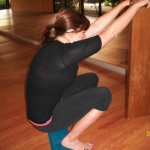If you want to start a fight at the next party you go to, bring up birthing politics. Hospital or Home. Drug-Free or Epidural. Birth Tub or Stirrups. But not so long ago, there was only one option. It was called, You're Doing This Now, Whether You Want To or Not.
I have no problem stating my personal preference for a natural, drug-free, non-hospitalized birth. The scientific and statistical evidence supports that, if all goes well, this is the ultimate in "healthy" experience for the mother and child.
One of the biggest supporting arguments of natural and non-hospital births is that the birthing process is a instinctual and natural event, happening for hundreds of thousands of years without outside aid. This is true. But there are many additional things the hunter-and-gathering mother were also doing that prepared the delivering muscles much better.
Looking back a hundred years, the birth-induced mortality rates (of both baby and mother) of non-industrialized civilizations were more favorable than rates of births happening in city areas. Medical journal articles from the 1800s were looking at this fact back even back then! Why were women who lived in the larger, industrialized areas of London having such a difficult time birthing than Gypsy women and Tinkers? The populations without medical intervention fared better (less death and cranial deformity in babies and less death or injury in the mothers) than those with the advantages of surgeons, antibiotics, and a more sterile environment. Why?
The answer back then, and still quite relevant today, had to do with movement habits, specifically the quantity of walking done per day as well as the practice of squatting to use the restroom. The squatting action, preferably done since birth, creates a wide pelvic outlet (the space where the baby passes out). Starting from childhood, squatting to bathroom aids in the ideal ossification (bone shaping) of both the pelvic bones and the sacrum. The wider the outlet, the safer and easier the baby passes through. Squatting also lengthens the muscles of the glutes, hamstrings, quadriceps, calves, and psoas. When these muscles are tight, they can actually reduce the movement of the pelvic bones and increase stress and pressure on the baby (and mama) during delivery. Back then and today still, the populations of people who move a lot (and I don't mean exercise an hour per day) have better, easier births.
If you want to go about a birthing process naturally, then you should add in the other "natural" processes women have been doing for years - walking 5-6 miles per day (this doesn't have to be done all at once), and restoring your muscles, joints, and bones to their correct function for a fluid and safe birth. Needing to "train" for delivery does not mean that the birthing process is not natural, only that the mother has let her "birthing equipment" adapt to un-natural living (sitting in chairs 5-10 hours per day, not stretching the bathrooming muscles of the pelvic floor and legs) and has become out of shape when it comes to whole-body endurance.
Whole-body endurance is your ability to walk long distances using the strength of the legs. Being able to support yourself with your leg weight will come in handy when needing to labor for an extended (but hopefully not too extended) amount of time. Cycling, aerobics, running, and swimming won't get you a stronger strength-to-weight ratio. A Hunting and Gathering mother needs to mimic the daily required walking that keeps her birthing muscles in top form.
Delivery Preparation
1. If you aren't walking at all, begin with one mile, increasing your distance by 1/2 a mile every two to four weeks, until you hit 5-6 miles per day. Doing all your mileage at once will help you with endurance, but if you are feeling tired or sore, break your distance up over the course of a day.
2. Start your squatting program NOW. Hamstring and calf tension (both muscle groups down the back of the legs) tuck the tailbone and pelvis under, instantly impacting the size of your delivery space. FUNNY STORY: I made the mistake of trying to teach my pregnant sister this exercise while she while she was giving birth. I'm not going to write down what she said here 🙂
Learn to squat:
Holding onto a door knob will help you until your legs are strong enough (and loose enough!) to hold you in this position for a minimum of one minute. A rolled towel or yoga mat under the heels will also make this exercise more easy to start. Work up to doing it with your heels on the ground!
Note: The picture on the left shows a tucked tailbone and rounded spine, NOT the position your are trying to achieve. Also note how far forward the knees have moved. To really open the pelvic muscles, un-tuck your tailbone by sticking out your bottom (see picture on the right and note that the knees are over the ankles). This will get your pelvic bones in the right birthing (and bathrooming) position.
Not giving birth in this life time? This information still applies to anyone wanting to optimize low back, pelvic floor, and digestive system health. If you haven't fully flexed your knees and hips in some time, it's best to start lying on your back, pulling your knees to your chest to "warm up" the joints. All over the world, 80-year olds drop down into this squat like it's no big deal, because they have been doing it three times a day at minimum! It's time to get started!
The more we prepare for delivery, the more successful the outcomes. The greater the success stories of natural birthing, the more it will be seen as a viable option. Make your natural birthing story by preparing...naturally!

